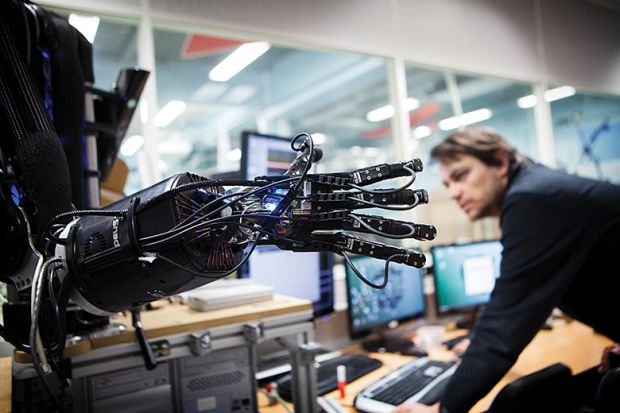The age of robot scientists able to generate cutting-edge knowledge on their own is drawing ever closer, experts have claimed, after an automated experimental facility at Massachusetts Institute of Technology reported that it had done more experiments in a single year in its field than all of the different laboratories in the world combined to date.
Robot scientists who can work autonomously round-the-clock to produce enormous amounts of data were, until recently, one of the more unlikely ideas mooted by futurists.
But, in a Science Robotics paper, fluid dynamics researchers describe how they set up an “intelligent towing tank” to test the vortex-induced vibrations created when a body is dragged through water – an important area applicable to shipping and ocean structures.
The robot was able to observe the results and plan a follow-up experiment, which it had done so 100,000 times in its first year, “essentially completing the equivalent of all of a PhD student’s experiments every two weeks”, says the paper.
“At a similar MIT laboratory, a typical doctoral student would finish her PhD in about five years, having completed no more than a thousand laborious experiments,” say the MIT researchers, who claim the new approach represents a “potential paradigm shift in conducting experimental research, where computers…robots and humans can collaborate in real time to accelerate scientific discovery”.
“This active learning approach to experimental research can be used across disciplines” beyond fluid dynamics, they argue, fulfilling the prediction made by the computing pioneer J.C.R Licklider 50 years ago that “in not too many years, human brains and computing machines will be coupled together very tightly, and that the resulting partnership will think as no human brain has ever thought”.
“Today, 20 years into the 21st century, we see such a vision being finally realised, with different scientific fields contributing to this metamorphosis of scientific inquiry and discovery,” the authors conclude. The paper cites a US Defense Advanced Research Projects Agency programme in which a computer reads tens of thousands of papers and synthesises a hypothesis that can be tested in a laboratory by humans as another example of robot scientists operating effectively. Meanwhile at Carnegie Mellon University, researchers are training robots to conduct chemical work, teaching them to decide how to modify substances and reactions without the need for human intervention.
Dixia Fan, the study’s first author and a postdoctoral associate in MIT’s department of mechanical engineering, said that while the robotic scientist was still in its early phases, the “amazing tools provided by the fast growing machine-learning community give a lot of opportunities for the intelligent automation of the scientific research”.
Speaking to Times Higher Education, Ross King, professor of machine intelligence at Chalmers University of Technology in Sweden, who led work on the first robot scientist “Adam” while at what is now Aberystwyth University, said he was impressed by the MIT project.
“It is not just that they have done a lot of experiments – they have managed to target and adjust the experiments so they are not doing things randomly,” said Professor King, whose “Adam” project, which began in 2004, was the first machine to autonomously discover scientific knowledge.
“For a few years [after Adam] nothing happened – but now everything is happening,” added Professor King on the progress of the robot scientist agenda. “Artificial intelligence has come of age in the past few years, so people are starting to work more and more in this area,” he added, noting that materials science and protein engineering were among the disciplines to embrace the use of robot scientists.
“Computers can have superhuman scientific skills – they can do logical reasoning and benchwork better than humans – and can complement the skills that humans have,” said Professor King, whose latest robot scientist Eve, which has successfully tested drugs for malaria, is referenced by the MIT paper.
However, Neil Lawrence, DeepMind professor of machine learning at the University of Cambridge, said that he was “very suspicious of all papers that suggest paradigm shifts”.
“Science doesn’t work as a series of paradigm shifts in the near term – those effects are long term and should be in the judgment of future generations,” said Professor Lawrence, who added the “reality [of such papers] is often [that they are] just ‘more interesting solid work’ than a paradigm shift”.
“I feel that Science and Nature – and their sub-journals – are becoming drivers of this unwarranted hype, and it’s not helped by the extent to which corporate entities get funding on the back of these types of hype,” Professor Lawrence continued, adding the paper contained “some potentially interesting new ideas but not much more than that.”
Asked if robot scientists might one day replace some of their human equivalents, Professor King replied that this was “not likely” in the foreseeable future.
“Scientists are still knowledge workers, and computers, however sophisticated, are a long way from that,” said Professor King, who nonetheless believed science would be increasingly driven by scientists and artificial intelligence working together.
“Garry Kasparov was beaten by the Deep Blue computer [in chess] back in 1996, but today’s computers will lose to humans if they can use computers too,” he explained, adding that “computers and humans are better than computers alone”.
POSTSCRIPT:
Print headline: Rise of the robot researcher
Register to continue
Why register?
- Registration is free and only takes a moment
- Once registered, you can read 3 articles a month
- Sign up for our newsletter
Subscribe
Or subscribe for unlimited access to:
- Unlimited access to news, views, insights & reviews
- Digital editions
- Digital access to THE’s university and college rankings analysis
Already registered or a current subscriber?








